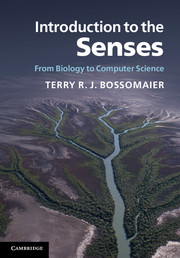
-
Select format
-
- Publisher:
- Cambridge University Press
- Publication date:
- July 2012
- June 2012
- ISBN:
- 9781139016001
- 9780521812665
- Dimensions:
- (247 x 174 mm)
- Weight & Pages:
- 0.86kg, 358 Pages
- Dimensions:
- Weight & Pages:
You may already have access via personal or institutional login
Book description
An understanding of the senses - vision, hearing, touch, chemical and other non-human senses - is important not only for many fields of biology but also in applied areas such as human-computer interaction, robotics and computer games. Using information theory as a unifying framework, this is a wide-ranging survey of sensory systems, covering all known senses. The book draws on three unifying principles to examine senses: the Nyquist sampling theorem, Shannon's information theory, and the creation of different streams of information to subserve different tasks. This framework is used to discuss the fascinating role of sensory adaptation in the context of environment and lifestyle. Providing a fundamental grounding in sensory perception, the book then demonstrates how this knowledge can be applied to the design of human-computer interfaces and virtual environments. It is an ideal resource for both graduate and undergraduate students of biology, engineering (robotics) and computer science.
Reviews
'The book concludes with … pages of useful and excellent references for those who want additional information … [it] is certainly interesting to read and will be useful for researchers using sensing technology in areas such as human-computer interaction or robotics.'
Ramaswamy Palaniappan Source: Computing Reviews
'Both the breadth and depth of Introduction to the Senses are impressive … More than anything, it serves to inspire. A go-to resource for pertinent ideas, this is indeed a reference book worth keeping on the shelf.'
Jean Huang Source: Yale Journal of Biology and Medicine
Contents
Metrics
Full text views
Full text views help Loading metrics...
Loading metrics...
* Views captured on Cambridge Core between #date#. This data will be updated every 24 hours.
Usage data cannot currently be displayed.
Accessibility standard: Unknown
Why this information is here
This section outlines the accessibility features of this content - including support for screen readers, full keyboard navigation and high-contrast display options. This may not be relevant for you.
Accessibility Information
Accessibility compliance for the PDF of this book is currently unknown and may be updated in the future.


